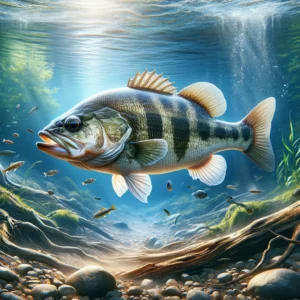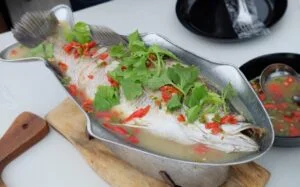Have you ever wondered what the optimal water temperature is for smallmouth bass activity? Well, you’re in luck! In this article, we will dive deep into the world of fish behavior and explore the ideal water temperature that gets these smallmouth bass swimming.
When it comes to smallmouth bass, temperature plays a crucial role in their activity levels. These fish are ectothermic, which means their body temperature is determined by the surrounding environment. On the cooler end of the spectrum, smallmouth bass tend to be less active, preferring to conserve energy. As the water temperature rises, their metabolism increases, resulting in heightened activity levels. However, there is an optimal temperature range where smallmouth bass are at their prime.
Studies have shown that smallmouth bass are most active when the water temperature ranges between 65°F to 75°F (18°C to 24°C). Within this temperature range, these fish are more likely to engage in feeding, hunting, and other activities. This is the sweet spot where their biological functions are efficiently regulated, allowing them to thrive and exhibit their natural behaviors.
Now that you have a basic understanding of the optimal water temperature for smallmouth bass activity, you’re ready to explore the intricate world of these fascinating fish in more detail. In the upcoming article, we will delve deeper into the factors that influence their behavior and discover some interesting tips and techniques to enhance your fishing experience. Stay tuned for a deep dive into the world of smallmouth bass!
The Optimal Water Temperature for Smallmouth Bass Activity
When it comes to fishing for smallmouth bass, understanding the factors that affect their activity is crucial for a successful outing. One of the key factors that plays a significant role in smallmouth bass behavior is water temperature. In this article, we will explore the optimal water temperature for smallmouth bass activity and how it impacts their metabolism, feeding patterns, and reproduction.
Water Temperature
Water temperature is a critical environmental factor that influences the behavior of smallmouth bass. Smallmouth bass are cold-blooded creatures, which means their body temperature is regulated by the surrounding water. They cannot actively control their body temperature like warm-blooded animals do. Therefore, the water temperature has a direct impact on their overall activity level.
The Importance of Water Temperature
Water temperature affects smallmouth bass in various ways. Firstly, it affects their metabolism. As the water temperature increases, their metabolism also increases, resulting in more energy expenditure. Secondly, water temperature influences their feeding patterns. Smallmouth bass are opportunistic feeders, and their feeding activity is driven by the availability of food. Lastly, water temperature impacts their reproduction. Smallmouth bass rely on specific temperature thresholds to initiate their spawning activities.
Optimal Water Temperature for Smallmouth Bass Activity
Smallmouth bass thrive in a specific temperature range that optimizes their activity level. The ideal temperature range for smallmouth bass activity is typically between 65 and 75 degrees Fahrenheit (18 to 24 degrees Celsius). Within this range, smallmouth bass are more active, aggressive, and responsive to lures and baits.
Effects of Cold Water on Smallmouth Bass
When the water temperature drops below the optimal range, smallmouth bass tend to become less active. Cold water slows down their metabolism, making them lethargic and less willing to chase after prey. Decreased feeding activity is also common in colder water, as smallmouth bass are less likely to expend energy searching for food.
Effects of Warm Water on Smallmouth Bass
On the other hand, when the water temperature rises above the optimal range, smallmouth bass become more active. Warmer water increases their metabolism, making them more energetic and aggressive in their feeding behavior. Smallmouth bass tend to feed more frequently in warmer water, taking advantage of the increased availability of prey.
Water Temperature Variability and Smallmouth Bass Activity
It is important to note that water temperature is not static and can vary throughout the year. Seasonal changes have a significant impact on smallmouth bass activity levels. During the spring and fall seasons, when the water temperature is closer to the optimal range, smallmouth bass are generally more active. In contrast, during the summer and winter seasons, when the water temperature is farther away from the optimal range, smallmouth bass may exhibit reduced activity.
In addition to seasonal changes, smallmouth bass activity can also be affected by daily fluctuations in water temperature. Factors such as sunlight exposure, air temperature, and incoming cool or warm water can cause daily variations in the water temperature, influencing the behavior of smallmouth bass. Furthermore, weather conditions, such as rain, wind, or cold fronts, can impact water temperature and consequently affect smallmouth bass activity.
Methods for Measuring Water Temperature
To monitor the water temperature accurately, fishermen have several methods at their disposal. One common method involves using temperature sensors that can be submerged in the water to provide real-time measurements. Another method is thermal imaging, which uses infrared technology to visualize the temperature distribution in a body of water. Additionally, handheld thermometers can be used to take spot measurements at various locations.
Monitoring Water Temperature for Fishing
Monitoring water temperature is essential for successful bass fishing. It helps anglers understand when and where smallmouth bass are likely to be most active. Temperature gauges integrated into fish finders are a popular tool among fishermen. These devices provide real-time water temperature readings and can assist in identifying areas with optimal conditions for smallmouth bass. Furthermore, there are various online resources that provide updated water temperature information for specific fishing locations.
Tips for Adjusting Fishing Techniques Based on Water Temperature
Understanding the relationship between water temperature and smallmouth bass activity can significantly improve fishing success. When the water temperature is on the colder side, it is important to adjust your fishing techniques accordingly. Choose lures that mimic slow-moving prey and slow down your retrieve speed. Additionally, targeting deeper water where the temperature may be slightly warmer can increase your chances of encountering more active smallmouth bass.
Conversely, when the water temperature is warmer, opt for lures that imitate faster-moving prey and increase your retrieve speed. Smallmouth bass are more likely to be feeding actively in warmer water, so targeting shallower areas where they may be actively chasing prey can yield better results. Adjusting your fishing depth to match the smallmouth bass’s preferred temperature range can also enhance your chances of a successful outing.
Conclusion
Water temperature is a critical factor that influences smallmouth bass activity. Understanding the optimal temperature range for smallmouth bass and how it impacts their metabolism, feeding patterns, and reproduction is crucial for successful fishing. Monitoring water temperature, adjusting fishing techniques accordingly, and targeting areas with optimal temperature conditions can greatly improve your chances of a productive day on the water. Remember to always consider the water temperature when planning your next fishing trip for smallmouth bass.




